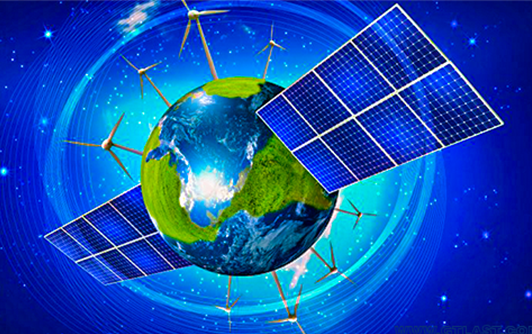Renewable energy is energy produced from sources that are naturally replenished and never depleted, such as the sun and wind. Renewable energy can be used for power generation, heating, cooling, and transportation.
In contrast, non renewable energy is produced from finite resources that may be used up, such as fossil fuels like coal and oil.
Types of Renewable Energy

Renewable energy sources such as biomass, geothermal, solar, water, and wind are natural resources that can be converted into clean, usable energy:
SOLAR ENERGY
Solar energy is the most abundant of all energy resources and is available even on cloudy days. The rate at which solar energy is intercepted by the earth is approximately10,000 times the rate at which humans consume energy.

Solar technology can be used for a variety of applications, including heat, cooling, natural lighting, electricity, and fuel. Solar technology converts sunlight into electrical energy through photovoltaic panels and mirrors that collect sunlight.
Not all countries are equally blessed with solar energy, but any country can make a significant contribution to its energy mix directly from solar energy.
The cost of manufacturing solar panels has dropped dramatically in the last decade, making them not only affordable, but often the least expensive form of electricity. Solar panels have a lifespan of approximately 30 years and come in a variety of shades depending on the type of materials used in their manufacture.
BIOENERGY
Bio energy is produced from a variety of organic materials called biomass. Bio mass can be wood, charcoal, manure, and other fertilizers for producing heat and electricity, and crops for liquid bio fuels. Most biomass is used for cooking, lighting, and heating in rural areas, generally by the poor in developing countries.
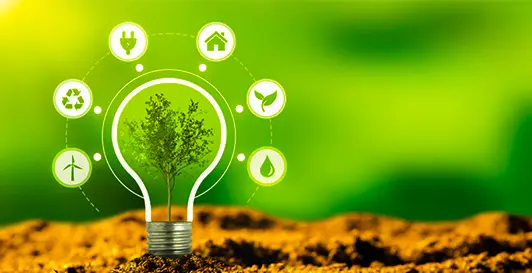
Modern biomass systems include dedicated crops, trees, residues from agriculture and forestry, and a variety of organic wastes.
The energy produced by burning bio mass emits green house gases, but at lower levels than burning fossil fuels such as coal, oil, and gas. However, given the large scale growth of forests and bio energy plantations and the resulting deforestation and land use changes that could negatively impact the environment, bio energy should only be used for limited purposes.
GEOTHERMAL ENERGY
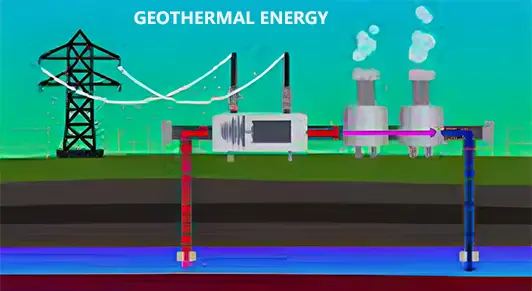
Geothermal energy harnesses the thermal energy available from the earth’s interior. Heat is extracted from geothermal reservoirs using wells or other means.
Reservoirs that are naturally hot enough hand permeable are called hydrothermal reservoirs, while reservoirs that are hot enough but modified by hydraulic stimulation are called enhanced geothermal systems.
Once at the surface, fluids of various temperatures can be used to generate electricity. The technology for generating electricity from hydrothermal reservoirs is mature and reliable.
WIND ENERGY
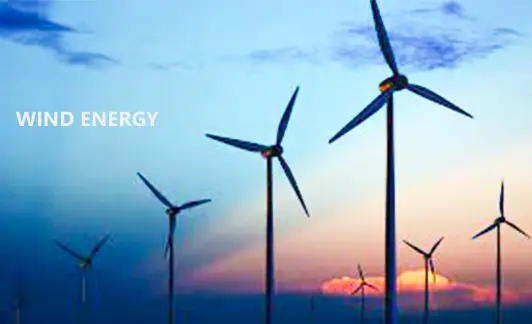
Wind energy harnesses the kinetic energy of moving air using large wind turbines installed on land (onshore) or in the sea or fresh water (off shore). Wind energy has been used for thousands of years, but onshore and offshore wind energy technologies have evolved over the past few years to maximize power generation, including increasing turbine height and rotor diameter.
Al though average wind speeds vary consider ably from place to place, the technological potential for wind energy in the world exceeds global electricity production, and there is sufficient potential in most regions of the world to enable significant wind energy deployment.
Although many areas of the world have strong wind speeds, the best locations for wind energy are sometimes remote. Off shore wind energy has tremendous potential.
HYDROPOWER
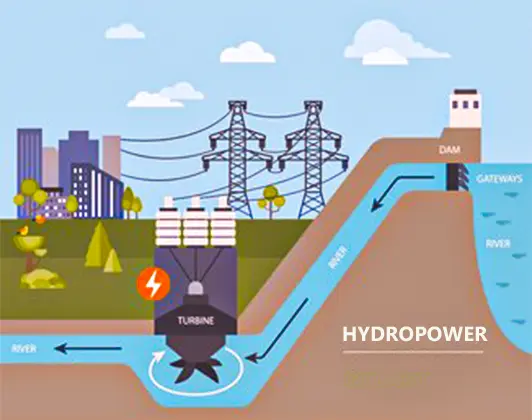
Hydropower generation uses the energy of water moving from higher elevations to lower elevations. Power can be generated from reservoirs and rivers. Reservoir hydropower plants use water stored in reservoirs, while run-of-river hydropower plants use energy from the available flow of rivers.
Hydropower reservoirs often have multiple uses, including not only energy supply, but also drinking water, irrigation, flood and drought control, and navigation services.
Hydropower is currently the largest renewable energy source in the power sector. Hydropower generation is generally dependent on stable rainfall patterns and can be adversely affected by climatic droughts and eco system changes that affect rainfall patterns.
The infrastructure required for hydropower generation can also negatively impact eco systems. For these reasons, many believe that small-scale hydropower is a more environmentally friendly option, especially for remote communities.
Wave Energy
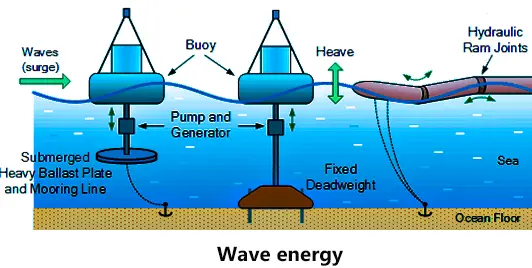
Wave energy technology captures the movement of waves in the ocean or sea and uses it to produce energy (usually electricity). The amount of energy produced depends on the speed, height, and frequency of the waves and the density of the water.
Waves are created by winds moving across the ocean surface and continue long after the winds have subsided. This complementarity makes wave energy a perfect partner for wind energy.
Tidal Energy
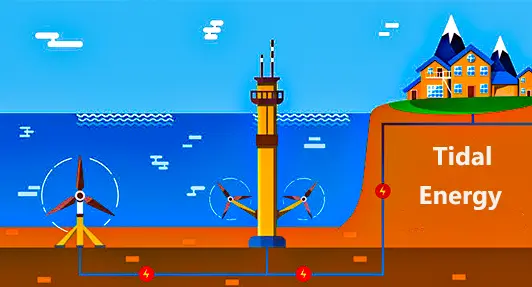
Tidal energy is a form of electric power generated by the natural ebb and flow of tides caused by the gravitational interaction of the earth, sun, and moon. Tidal currents with sufficient energy to generate electricity occur when water passes through a constriction, causing the water to move faster.
With specially designed generators in appropriate locations, tidal energy can be converted into useful power, such as electricity. Other forms of energy can also be generated from the ocean, such as waves, sustained ocean currents, and temperature and salinity differences in seawater.
Benefits of Renewable Energy
The benefits of renewable energy are numerous and impact the economy, the environment, national security, and human health. The following are just a few of the benefits of renewable energy use in the United States:
- Enhanced reliability, security, and resiliency of the nation’s electric grid.
- Job creation in the renewable energy industry.
- Reduced carbon emissions and air pollution from energy production.
- Increased U.S. energy self-sufficiency.
- Easier purchasing of many renewable energy sources because they are cost-competitive with conventional energy sources.
- Expanded access to clean energy in communities that are not connected to the grid or in remote, coastal, and island communities.
Renewable Energy in the United States
Renewable energy sources generate about 20% of all electricity in the U.S., and that share continues to grow. The following chart shows the share of renewable energy in total electricity generation in 2021.
In 2022, solar and wind power are expected to add more than 60% (46% solar and 17% wind) of the utility-scale generating capacity of the U.S. grid.
Office of Energy Efficiency and Renewable Energy
The U.S. Department of Energy’s Office of Energy Efficiency and Renewable Energy (EERE) is the center for renewable energy applications research, development, and demonstration activities in the United States.
EERE has three pillars: renewable energy, sustainable transportation, and energy efficiency. The renewable energy pillar consists off our technical offices:
- Geothermal Technologies Office
- Solar Energy Technologies Office
- Water Power Technologies Office
- Wind Energy Technologies Office
EERE’s Bio energy Technical Office and Hydrogen and Fuel Cells Technical Office con duct R & D activities in renewable energy under the Sustainable Transport pillar, while the Technical Office of the Energy Efficiency pillar integrates renewable energy into its work.
Promoting Renewable Energy in the United States
EERE funds research and development to advance clean energy technologies. Find out about available funding opportunities and learn how to apply for funding.
The U.S. Department of Energy’s 17 national laboratories conduct research and help bring renewable energy technologies to market Learn more about EERE’s national laboratories and technology marketization programs.
Renewable Energy at Home
Homeowners and renters can take advantage of clean energy in their homes by purchasing green power, installing renewable energy systems to generate electricity, and using renewable resources for water and space heating and cooling.
Before installing a renewable energy system, it is important to reduce energy consumption and improve the energy efficiency of your home.
Visit Energy Savers to learn more about the many ways renewable energy can be used in your home:
-Buying Clean Electricity
-Planning a Renewable Energy System for Your Home
-Small wind power systems
-Solar power at home
-Micro-hydropower systems
-Solar water heating
-Active solar heating
-Geothermal heat pumps
-Passive solar homes -Outdoor solar lighting


